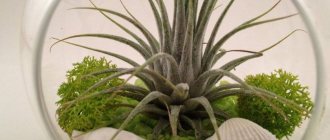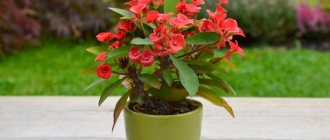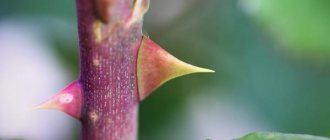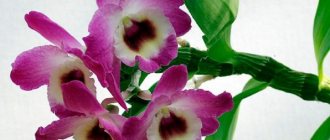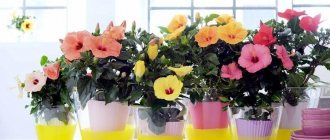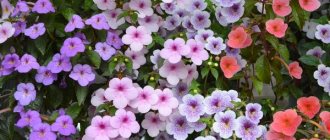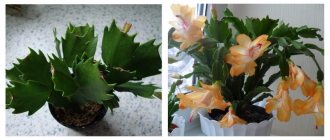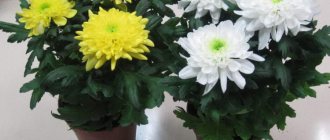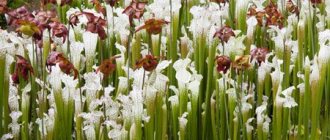Cooper's variegated hibiscus - home care
Hibiscus is best known to gardeners under the name Chinese rose. This plant is grown indoors and outdoors. The following varieties of hibiscus can be grown at home: Trifoliate, Syrian, Chinese, Drummond, Variable and Variegated.
The content of the article:
1. Hibiscus Cooper - description of the plant 2. Hibiscus "Cooper": care 3. Reproduction methods 4. Medicinal properties
Subspecies
Flower growers successfully grow several variegated varieties of hibiscus.
- Cooper's hibiscus (Hibiscus rosa-sinensis var. cooperi). The name was coined in honor of Daniel Cooper, who brought it to the UK from the French Pacific territory of New Caledonia.
- Hibiscus "Carnival" (Hibiscus rosa-sinensis var. cooperi carnival). It has predominantly pink shades in the bud.
- Hibiscus "Snowquin" or "Snowflake" with variegated leaves, and there is more white in its color than other species. It has leaves of a different shape, and the bush itself is small in size. During flowering, scarlet buds bloom on it.
- Hibiscus 'Rose Flake' . The leaves are colored green-white-pink, and the buds are bright scarlet.
Description of the plant Hibiscus "Cooper" variegated
The variegated variety of Chinese rose belongs to the Malvaceae family. In indoor conditions, with proper care, the plant can live for two decades. The variegated variety has another widely known name - Cooper's hibiscus. The flowering period falls in the spring-autumn season, where each inflorescence manages to exist for 1-2 days. After this, the flower fades, and in its place a five-leaf box with fluffy seeds is formed.
The plant with variegated leaves owes its name to the man who first brought it to Europe. Daniel Cooper brought hibiscus from Southern China. The current distribution area of the plant is very extensive. This representative of the flora is found in China, Sri Lanka, Indonesia, and the Hawaiian Islands. The tropical climate allows the plant to reveal itself in all its glory, because with sufficient sunlight the plant’s foliage acquires a decorative variegated color.
Good to know!
The color of the Cooper hibiscus leaf will depend on the lighting, soil composition and fertilizing.
Heterogeneous leaf color can occur even on one plant, where some will be completely green, others with a red, yellow or white tint. Inflorescences can reach significant sizes and have a simple or complex flower shape.
The plant can be molded without any problems. It is recommended to prune in the fall before the plant enters the dormant phase, or in the spring after it awakens. Any type of pruning will benefit the plant, as it will stimulate branching and active flower growth.
Hibiscus "Cooper" with good care can bloom all year round.
Beautiful inflorescences with a long pink stamen on a young plant can appear already in the first year of life.
Beautiful flowers!
• Black rose BLACK BACCARAH • Hydrangea paniculata VANILLA FRAZE • Liana WISTRINA
The plant is valued not only for its beautiful inflorescences, but also for the decorative appearance of its foliage.
Often the leaf has a bright color with red or white splashes. Hibiscus "Cooper" has red inflorescences and foliage edges. In other plant species, the color of the flowers can be coral, yellow, orange, or purple.
Growing Chinese roses from seeds
Among inexperienced gardeners, the seed method of propagating perennial flowers is not very popular; they prefer to propagate such plants vegetatively, since this is a faster and more effective method. However, the Chinese rose is one of those plants that are easily propagated both by seed and by cuttings. The fact is that hibiscus seeds have a very high germination rate, and the crops do not require special care, so growing such a rose from a seed is really very simple. It should also be taken into account that the seed material of such a plant remains viable for 6 years.
Sowing of seeds is carried out in the last days of February. Shortly before sowing, the seed material is immersed in a pink potassium manganese solution for 30 minutes, after which it is thoroughly washed under running water. After this, it is placed for 24 hours in a solution of a growth stimulating agent (Zircon, Epin or Fumara), making sure that it only slightly covers the seeds, otherwise the embryos may die due to lack of oxygen. Next, the seed material is placed in moistened gauze for germination; do not forget to provide it with systematic ventilation. In order for the seeds to hatch, they will need a large amount of heat and moisture. In this regard, after they are placed in wet gauze, they are placed in a polyethylene bag, which has several holes through which air will flow to the seeds. After the sprouts appear, and as a rule, this happens on about the third day, the seeds are planted in separate plastic cups with a volume of 0.5–1 liter. They are filled with a substrate consisting of peat, sand and wood ash. Make sure that the main root of the seedling does not twist or bend during growth. The planted seeds are covered with a thin layer of soil mixture, and the containers are covered with paper (film) on top.
In order to prevent blackleg, seedlings are shed with a weak solution of Fundazol. For the same purpose, provide the plants with moderate watering. In order for them to grow and develop well, they will need a large amount of diffused light; be sure to protect the seedlings from direct rays of the sun.
Hibiscus "Cooper": home care
All ornamental plants need full natural light. This must be taken into account when choosing a location for the Cooper hibiscus. An unsuccessfully chosen zone will slow down the growth and development of the indoor beauty.
The variegated Cooper's hibiscus should expect abundant flowering in March, which can last until the last month of autumn.
Preference should be given to the eastern and western windows of the room.
Cooper Hibiscus Care Video
The recommended ambient temperature is +20...+25C in summer, and in winter it should not be lower than +13C.
Direct rays of the sun in the hot season cause damage to hibiscus foliage (burns), so it is necessary to shade it.
If there is a sudden change in the growth zone, the plant may suffer, so it should be accustomed to the new conditions gradually.
During active growth and development of the Cooper hibiscus, regular watering should be provided.
The soil should be slightly moist at all times. Radical drought and waterlogging of the soil will harm the root system of the plant. To create optimal conditions, the top layer of soil in a flower pot can be mulched. Excess liquid from the pan must be drained.
It is recommended to clean the stems and foliage of dust with a shower, which will serve not only as a cleansing procedure, but also as a prevention against certain diseases.
To ensure soil breathability, it is recommended to loosen the top layer of soil after watering.
Photo of Cooper's variegated hibiscus
The normal process of flower bud formation occurs at an air temperature of at least +15C.
In winter, when the indoor air is excessively dry, it is recommended to regularly spray the foliage of the plant.
Good to know: what to feed indoor plants in winter
If the variegated hibiscus has reached a significant size, then it is not replanted, but only the top layer of soil in the container is replaced, having previously removed the previous soil.
Before changing the soil and flower container, variegated hibiscus should be pruned. The cuttings obtained after rejuvenating pruning can be used as planting material, having previously rooted them.
Recommended composition of soil mixture for planting:
- turf soil (2 times more than other components);
- humus;
- peat;
- sand.
You cannot plant a flower in cold soil.
This is fraught with the slow death of the root system. Fertilizing hibiscus "Cooper" should be done alternately with a mineral and complex base. Fertilizer category: flowering indoor plants. The frequency of fertilizing is once every 21 days.
Preparing the bush for winter
In the middle zone, hybrid or Syrian hibiscus must be covered.
In regions with harsh winters, the plant is dug up, planted in a large pot or container and placed in a basement or other cool place until spring, after which it is planted again in open ground in the spring. If the hibiscus waits out the winter in the garden, then in the second half of November a frame should be built around it, onto which agrotex, spunbond or lutrasil is stretched. If the frosts are not severe, the plant will be reliably protected in this way. But the best way to help protect hibiscus from frost is to cover it with spruce branches. They cover it with spruce branches in three layers, laying branches like a hut, after tying the bush with a rope and putting a sackcloth bag on it. True, rodents often climb into such a shelter and eat the bark on the plant, dooming it to death. To prevent rats or mice from destroying the hibiscus, you need to place mousetraps around it or place poisoned bait under cover. Growing and caring for a plant such as garden hibiscus is quite an exciting activity. Herbaceous varieties can winter well under cover. This shrub is often used as a hedge because it looks very attractive.
Cooper's hibiscus propagation methods
To obtain a young plant, you can use one of three methods:
- rooting green cuttings;
- rooting stems;
- rooting of semi-lignified cuttings.
Video about cutting hibiscus
The suitable breeding season for hibiscus is the end of winter - the beginning of spring, mid-summer, early autumn.
Soil and water are equally suitable for rooting. The recommended substrate consists of sand and peat. An alternative to these methods is rooting in a peat tablet. Each of the proposed methods gives good results, the result of which are roots after three weeks.
Similar representatives of the flora
- Dwarf phytonia will delight its owner with the same bright variegated leaves as the Variegated Hibiscus. Different varieties of phytonia have different colors: there are plants with silver inclusions, and others with pink ones.
- Hypestes has large leaves, on which bright red and green colors coexist.
- Maranta is even more surprising; its leaves are almost symmetrically arranged in different color blocks: red, light green and dark green.
- Abutilon, a small indoor tree, belongs to the same family as the hibiscus, and therefore its flowers are very similar in shape to the flowers of its brother (you can find out what tree-like types of hibiscus are and how you can form a bonsai here).
- Mallow flowers also have a beautiful flower shape similar to hibiscus.
Caring for hibiscus is not that difficult. A couple of simple rules, and it will delight you with long-lasting flowering and a sophisticated appearance.
Hibiscus "Cooper": medicinal properties
It is no secret that hibiscus tea is a drink made from hibiscus petals. The drink is beneficial for human health, but it also has a number of contraindications.
Hibiscus or Cooper's hibiscus should not be consumed by people with a confirmed diagnosis of a stomach ulcer, gastritis and in children under 1 year of age.
Medicinal properties of the red drink:
- choleretic;
- diuretic;
- laxative;
- antibacterial;
- anticonvulsant.
The information presented makes it clear that Cooper's hibiscus is not an overly demanding plant. It is enough to choose a suitable growing place for it, provide regular watering and pruning, and the owner will be pleased with the result.
Diseases and pests
Cooper's hibiscus rarely gets sick, but if not maintained correctly, the following difficulties may arise:
- The leaves turn yellow and fall off. This happens when a plant is overwatered. It is necessary to reconsider the water application regime.
- The tips of the leaves curl. Hibiscus does not have enough fertilizing. Apply mineral fertilizers.
- The plant completely withers. The room has dry air or insufficient watering. Moisten and spray more often.
The flower can be attacked by pests such as spider mites, aphids and scale insects. When they are first detected, the leaves are immediately wiped with a damp sponge dipped in soap or tobacco solution. If the infestation is severe, insecticidal preparations are used to destroy them.

